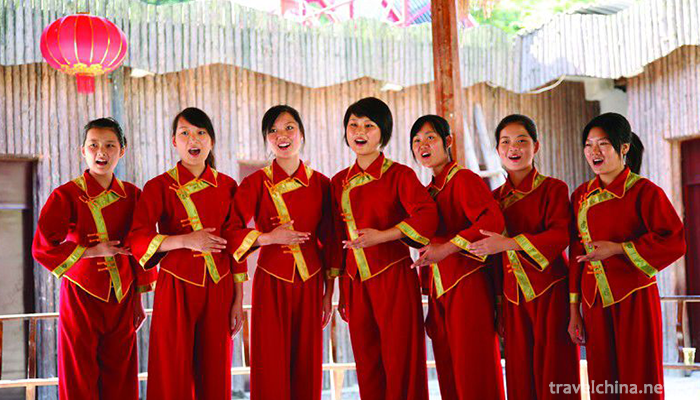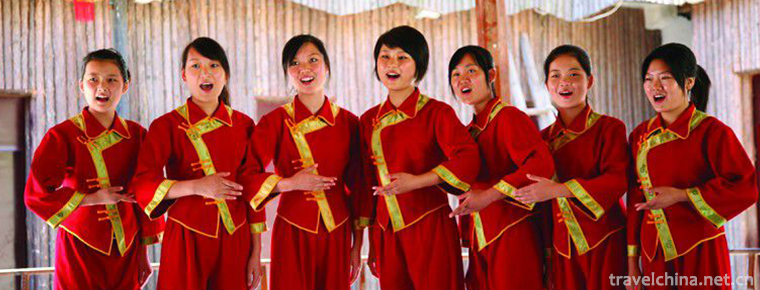Lv Jiahe Folk Song
Lv Jiahe Folk Song
Lvjiahe Folk Song is a kind of folk song which is popular in Lvjiahe Village, Guanshan Town, Danjiangkou City, Hubei Province. Located in Wudang Mountain Scenic Area, the village retains a large number of original folk songs and singers due to the blocked terrain. It is the second batch of national intangible cultural heritage list, Hubei Folk Song Village and the first village of Chinese folk song. The folk songs of Lujiahe can be divided into three categories according to their contents: Yin songs, Yang songs and long narrative poems. The melody of Lvjiahe folk song is very beautiful, including the lingering of Jiangnan minor and the bold and unconstrained of northern folk song, the mellow melody of Central Plains melody and the high-pitched folk song of Northwest China.
historical origin
Lvjiahe folk songs have a long history. The Book of Songs is the first collection of poems in China. Guan Yong is the opening chapter of The Book of Songs: "Guan Yong dove, in the river state, fair lady, gentleman is good." The lyrics of a folk song "It's hard to make shoes for my sister every year" are: "Guan Guan Yongyu's shoes are sent to us on the river island. It's hard for a fair lady to make shoes for you. Every year she makes shoes for her sister." The lyrics of this folk song are similar to those of Guan Yong. Whether Guan Yong is a folk song processed by the collector on the basis of "making shoes for my sister every year", or "making shoes for my sister every year" is the spread and variation of Guan Yong among the people, it shows that there is a certain relationship between them. According to historical records, Yin Jifu, the Taishi Master of Zhou Xuanwang, was not only the collector of the Book of Songs, but also the singer of the Book of Songs. He was from Fangling, and the Chronicle of Fangxian contains: "Zhou, Yin Jifu, Fangling, Xuanwang, who was collected in Fang, was given by poets. The death of June is the Qingfeng Mountain of the funeral home." Wudang Mountain is only 10 miles away from Gufangling Mausoleum, which shows that before the Spring and Autumn Period in the Western Zhou Dynasty, there were a large number of excellent ballads preserved here, and the trend of collecting poetry was prevalent.
Wudang Taoist temple was built from 627 to 649 (Zhenguan period of Tang Dynasty), and it had a considerable scale from 960 to 1279 (Song Dynasty). Wudang Mountain was overhauled in Yuan Dynasty and Ming Dynasty. It took 13 years to mobilize 300,000 migrant workers throughout China. 300,000 migrant workers come from the north and south of the Yangtze River. They also bring songs from all parts of China. The town of Guanshan, where Lujiahe Village is located, was a believer granary specially designed to provide food for migrant workers in Wudang Mountain when they were building Wudang Mountain. So it's not surprising that Lv Jiahe's folk songs are rich and the tunes are wide.
Inheritance situation
In 1999, when it was discovered by experts and scholars, it began to understand how profound the mystery and cultural connotation were. In 2001, Lujiahe Village was officially awarded "Hubei Folk Song Village" by Hubei Folk Literature and Art Association. The village was awarded the title of "The First Village of Chinese Folk Songs" after a meeting of experts from the Chinese People's Association, the Hubei Provincial Literary Union and the Hubei Provincial People's Association. In order to do a good job in the protection and development work, the local government, while building the "South Shinto" leading to Wudang Mountain and opening the tourist routes from Lujiahe to Wudang Mountain, put forward the overall development idea of "folk songs set up platform, tourism driven, economic opera singing", so as to make the folk songs of Lujiahe walk out of the mountain village.
According to the survey in 2003, the population of Lujiahe is less than 200 households. There are 85 folk singers, of whom 4 can sing more than 1,000 songs in a row. Among the singers are both dolls of several years old and old people in their 80s. After preliminary arrangement, there are more than 4000 folk songs.
artistic characteristics
The melody of Lvjiahe folk song is very beautiful, including the lingering of Jiangnan minor and the bold and unconstrained of northern folk song, the mellow melody of Central Plains melody and the high-pitched folk song of Northwest China. From the collected folk songs of Lujiahe in the early 21st century, we can see that they are rich in content, beautiful in tune and lively in singing forms. For example, "Yangge" is mainly about love between men and women, involving all aspects of daily life. Most of them are funny and interesting, singing "greeting song", "accompanying song" and "crying marriage song" when they get married; singing "making a New Year's song" when they get married; singing "warming house song" when they live in a new house; and singing "advising drinking song" when they drink. For example, "Sister Xiangzhong Brother is a man, the thunder splits the ground and does not change the heart" is sung in "Dongfang Song". Look forward to brother squeaks, sister is your people. My brother is my sister's bosom friend. When the moon rises in the east, the song will play until dawn.
Lujiahe's Yangge is closely related to people's living customs, and accompanies people in all aspects of life. Villagers regard singing as the second language of communication. As long as it is a good thing in life, it can be found in singing, just like sunshine, it is indispensable in villagers'life.
Main classification
The folk songs of Lujiahe can be divided into three categories according to their contents: Yin songs, Yang songs and long narrative poems. Yin songs are sung at funerals, which account for almost 70% of the total number of Lvjiahe folk songs. After paying homage to the deceased, the singer took a step toward the bereavement while singing a "song head". 360 "song heads" finished singing and just entered the bereavement home. Next is the second part of the "song of admonishing kindness", first singing that children should be filial to their parents, then singing that families should live in harmony, friends should treat each other sincerely, and working to become rich, thrifty and so on. For example, it tells about the hard work of mothers in raising babies: "The mother sleeps wet and the baby sleeps dry, the left side sleeps wet and the right side sleeps wet and the left side sleeps wet. If both sides are wet, the mother asks her son to sleep in front of his chest..." The third part is called "turning over the ridge". Singers begin to sing and fight songs. Both sides compare knowledge, wisdom and character by singing. You can sing from one generation to the next, from the Ming, Yuan, Song, Tang Dynasty to the next. Singing in the middle of the night, everyone was in high spirits and never tired. At dawn, to carry the dead to the mountains and bury them, singers sang "Return the Sun Song" on the mountains to send the dead away and usher in a sunny new day.
Except Yin Song, they are all called Yang Song. Such as festival song, lamp song, drinking song, birthday song, labor song, children's song, riddle song, shepherd's war song, etc. Yangge is closely related to people's daily customs. Singers can sing different songs according to different scenes and customs. Such as digging and weeding, singing labor songs, singing festive songs on New Year's Day, singing birthday songs, building houses, singing Liangge.
Lujiahe also has many long narrative poems, such as "Three Sisters of the Dragon worship their birthday", "Du Jilian crying prison", "Liang Shanbo and Zhu Yingtai", "beating barbarian boats", "Qin Xuemei hanging filial piety" and so on. These songs can be sung either in the sun or in the yin, but only in different tunes. Preliminary statistics show that there are more than 15 folk narrative poems handed down by Lv Jia River.
Non heritage information
Heritage Level: The Second Batch of National Non-material Cultural Heritage
Approval serial number: 582
Item No. II-83
Project Name: Lvjiahe Folk Song
Applicant: Danjiangkou City, Hubei Province
Heritage category: folk music
Approval No. 19, Guofa
Approval date: 7 June 2008.


-
1.Pagoda of Xing Jiao Temple
Hingjiao Temple Pagoda is located in the original Hingjiao Temple of Shaoling, Chang'an District, Xi'an Province, Shaanxi Province. It is a famous figure in the history of Buddhist communication
Time 2018-12-24 -
2.Old Stork River Drifting
Xixia Guanhe Drifting Scenic Area is a national AAAA-level tourist attraction and a part of Funiushan World Geopark in Nanyang, China. Xixia County, Nanyang City
Time 2019-01-29 -
3.Hui Banquet Song
The Hui banquet song is one of the folk songs sung by the Hui people at weddings, festivals and Islamic festivals. Also known as "Family Music" and "Vegetable Music".
Time 2019-05-04 -
4.Riddle
Riddles mainly refer to hidden words, such as allusions or words, which can be guessed by others. They can also be extended to things containing mysteries. Riddles originated from ancient Chinese folk
Time 2019-06-04 -
5.Wenzhou embroidery
Ou embroidery, also known as painting curtain, is a local traditional art in Wenzhou, Zhejiang Province. It is produced in Oujiang area. It is also one of the special handicraft products of "thre
Time 2019-06-08 -
6.Reba Dance
Reba dance is a form of dance performed by Tibetan "Reba" artists. Reba is a group of street artists who make a living selling arts (usually composed of family as the basic unit) performing,
Time 2019-06-11 -
7.Shannan Menba Opera
Because Shannan Menba Opera directly adopts Tibetan scripts of Tibetan Opera, it is called "Menba Aguiram" by the people, that is, Menba Tibetan Opera. Legend has it that at the end of the 1
Time 2019-06-13 -
8.Taishan Stone Dang Custom
Taishan Stone Dangdang Custom is a relic of ancient people's worship of spiritual stones. Mountain and stone are regarded as personality by myth, which is a typical traditional folk culture that has b
Time 2019-06-18 -
9.Transportation in Panzhihua
By the end of 2018, Panzhihua had 3733.91 kilometers of grade roads and 195 kilometers of expressways. In the whole year, the highway passenger traffic volume was 20.79 million person times, the passenger turnover volume was 597.18 million person kilometers,
Time 2020-12-14 -
10.Social undertakings in Luzhou
As of the end of 2018, Luzhou has added 1 provincial key laboratory, 1 provincial engineering technology research center, 4 incubators of science and technology enterprises above the provincial level, and 16 national high-tech enterprises. The annual output value of high-tech reached 38
Time 2020-12-14 -
11.Neijiang ten sages
Ten sages are outstanding representatives of historical figures in Neijiang, which are described as "one division, two phases, three number one scholars and four great masters";
Time 2020-12-16 -
12.Neijiang population
By the end of 2019, the total population of Neijiang's household registration was 4 million 81 thousand and 800, a decrease of 35 thousand and 900 from the end of last year, of which 2 million 103 thousand and 400 were male and 19 thousand were reduced
Time 2020-12-16